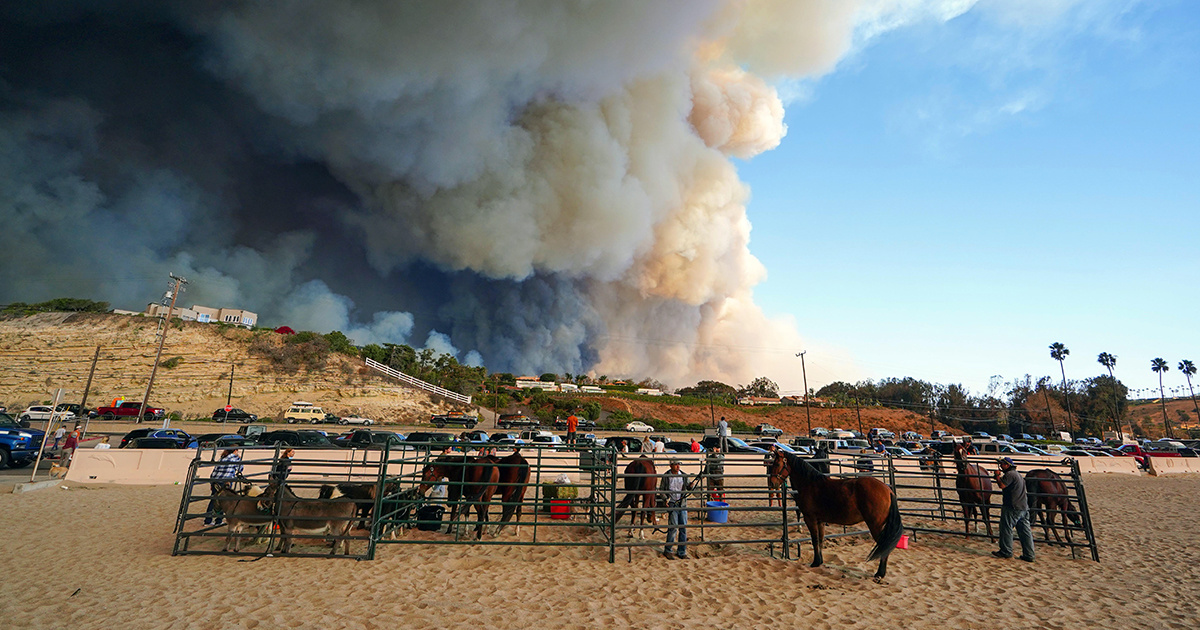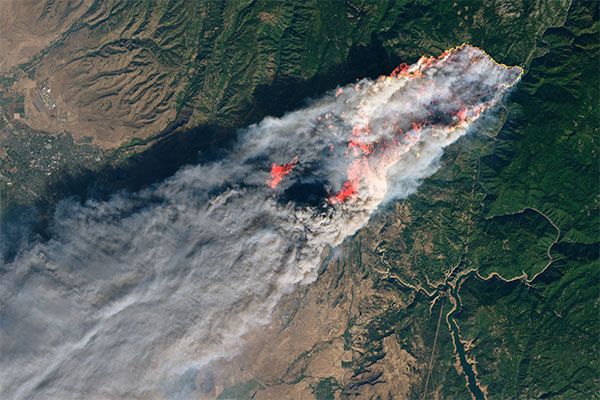
31 Dead, 250,000 Evacuated in California Fires as Governor Blames Climate Change

Evacuated horses wait on Zuma beach as the Woolsey Fire rages in Malibu on Nov. 9. Scott Varley / Digital First Media / Torrance Daily Breeze via Getty Images
California suffered a devastating weekend as wildfires raging in both the south and north of the state killed 31 and forced 250,000 to flee their homes, BBC News reported Monday. More than 200 people are still missing.
The Camp Fire, which destroyed the town of Paradise Thursday, tied the 1933 Griffith Park fire in Los Angeles for the deadliest fire in California history when the death toll reached 29. It is also the most destructive in terms of the number of structures burned, with a total of more than 6,700 as of Saturday, ABC 7 News reported. So far it has burned more than 109,000 acres and is almost 25 percent contained as of the most recent reporting by BBC News.
A helicopter gets water from the Feather River to do an airdrop on the #CampFire. The #CampFire has already destroyed more than 6,700 structures, making it one of the costly of all time. @latimes pic.twitter.com/ND1JQQ05aU
— Carolyn Cole (@Carolyn_Cole) November 11, 2018
In the south, the Woolsey and Hill fires also continued to rage. The Woolsey fire killed two and damaged homes near the famous Malibu beach. As of Sunday, it had burned 83,000 acres and at least 177 buildings and was 10 percent contained. The Hill Fire nearby had burned 4,530 acres and was 75 percent contained.
Stunning timelapse video shows the destructive #WoolseyFire spreading into Malibu, as seen from Venice Beach, about 20 miles away.
At least 31 people have died this week as massive wildfires continue raging across California. https://t.co/N083uWj0Dv pic.twitter.com/Vk0N8UECgQ
— ABC News (@ABC) November 12, 2018
California Governor Jerry Brown unequivocally blamed climate change for the devastation.
“This is not the new normal,” he said Sunday, as reported by The Sacramento Bee. “This is the new abnormal, and this new abnormal will continue certainly in the next 10 to 15 years.”
The fires were also driven by hot winds from the east that further dried vegetation already parched from unusually low rainfall, as University of Nevada atmospheric scientist Neil Lareau explained in Wired. But climate change makes that worse.
“All of it is embedded in the background trend of things getting warmer,” Lareau explained. “The atmosphere as it gets warmer is thirstier.”
If Northern California had received anywhere near the typical amount of autumn precipitation this year (around 4-5 in. of rain near #CampFire point of origin), explosive fire behavior & stunning tragedy in #Paradise would almost certainly not have occurred. (1/n) #CAfire #CAwx pic.twitter.com/2LBKjSVBMF
— Daniel Swain (@Weather_West) November 10, 2018
Tellingly, five of the 10 most destructive California fires listed by ABC 7 News occurred in the past two years.
But that wasn’t the line taken by President Donald Trump, who blamed poor forest management, not global warming, for the blazes. In a tweet Saturday, he even threatened to withdraw federal money if the state didn’t improve management.
https://twitter.com/realDonaldTrump/statuses/1061168803218948096
Firefighters instantly pushed back on his rhetoric.
“The President’s message attacking California and threatening to withhold aid to the victims of the cataclysmic fires is ill-informed, ill-timed and demeaning to those who are suffering as well as the men and women on the front lines,” California Professional Firefighters President Brian K. Rice said, according to CNN.
He also said his tweet was plain wrong.
“Wildfires are sparked and spread not only in forested areas but in populated areas and open fields fueled by parched vegetation, high winds, low humidity and geography,” he said.
Trump modified his tone later Saturday, praising the firefighters for their work and closing with “God Bless them all.”
https://twitter.com/realDonaldTrump/statuses/1061382890100002817
But on Sunday, he tweeted again that the fires would stop with “proper fire management.”
https://twitter.com/realDonaldTrump/statuses/1061554334276747264
In fact, the federal government owns 57 percent of California’s forested land, while state agencies only control three percent. The rest is owned by private individuals, families, companies or Native American tribes, according to University of California data.
Brown asked Trump on Sunday to declare the fires a major disaster, a move that would allow more federal resources to flow to California to help with relief and recovery. In his remarks, Brown didn’t mention Trump by name, but his emphasis on climate change contained an implicit rebuke.
“Managing all the forests everywhere we can does not stop climate change, and those who deny that definitely are contributing to the tragedies that we are witnessing and will continue to witness,” Brown said, according to The Sacramento Bee.
The Camp Fire as seen from space when it broke out on ThursdayNASA / Operational Land Imager on Landsat 8
- How Climate Change Ignites Wildfires From California to South Africa
- 'Wildfires Are Climate Fires': How to Discuss the Climate Crisis - EcoWatch

 233k
233k  41k
41k  Subscribe
Subscribe 
